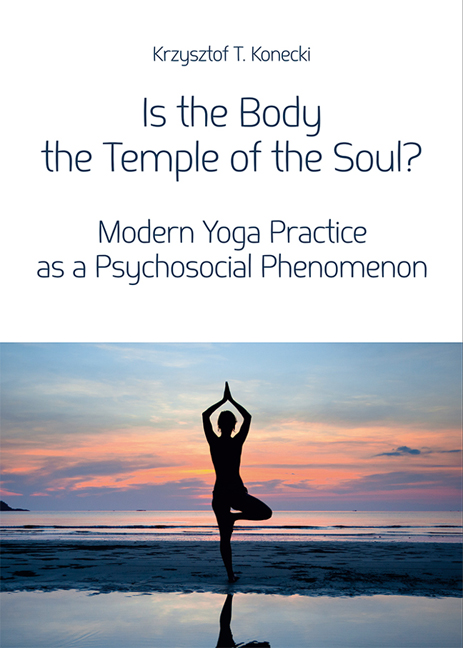Book contents
- Frontmatter
- Contents
- Foreword (Michał Szczepanik)
- Introduction
- Chapter 1 Philosophy and hatha-yoga practice. Para-religious aspects of hatha-yoga
- Chapter 2 The social world of yoga practice
- Chapter 3 Commonsense definitions of yoga and its meaning for practitioners
- Chapter 4 The process of becoming a hatha-yoga practitioner
- Chapter 5 Visual transmission of knowledge and the meaning of corporality and gestures in the social world of yoga practice
- Chapter 6 Emotions and yoga practicing. Working on emotions and achieving “emotional culture” without emotions
- Chapter 7 Teacher and guru in hatha-yoga practice
- Conclusions
- Bibliography
Chapter 2 - The social world of yoga practice
Published online by Cambridge University Press: 10 January 2018
- Frontmatter
- Contents
- Foreword (Michał Szczepanik)
- Introduction
- Chapter 1 Philosophy and hatha-yoga practice. Para-religious aspects of hatha-yoga
- Chapter 2 The social world of yoga practice
- Chapter 3 Commonsense definitions of yoga and its meaning for practitioners
- Chapter 4 The process of becoming a hatha-yoga practitioner
- Chapter 5 Visual transmission of knowledge and the meaning of corporality and gestures in the social world of yoga practice
- Chapter 6 Emotions and yoga practicing. Working on emotions and achieving “emotional culture” without emotions
- Chapter 7 Teacher and guru in hatha-yoga practice
- Conclusions
- Bibliography
Summary
What is the social world?
The social world is some form of association based on mutual interests and the undertaking of various actions by individuals, and this is what defines belonging to this world.
Here, I use the term ‘social world’ as it was described in interactional sociology by A. Strauss (1978; 1982) and his successors (Becker 1982; Star, Griesemer 1989; Clarke 1991; see also Kacperczyk 2005).The social world centers around some basic actions which it selects. You can distinguish many social worlds, for example, the world of qualitative researchers, the world of practicing yoga, the world of climbers, the world of dance, the worlds of postage stamp collectors, non-conventional medicine, tourist travel, etc. While the world contains spaces where the action can be carried out, technology, especially innovative technology, also which allows one to carve out for a given world both symbolic and physical space. In a social world, we usually encounter some division of work. Some persons deal with justifying the existence of the given social world (legitimization and theorization, as well as public relations), others searching for new spaces for extending its work, others are involved in the development and teaching of technical skills, etc. Some do all of these things on their own. There are also many auxiliary activities, such as defense and attack, creating associations, which help to achieve the main action (Strauss 1978; Kacperczyk 2005). Arenas of disagreement also arise: who is an authentic member of this world, what are its boundaries, what are the justifications for its existence (so-called legitimization), and so forth. Sometimes there is a boundary object around which the disagreement takes place.
The definition of ‘belonging’ to a particular world is connected with the performance of certain primary activities which, in the case of hatha-yoga, involve performing certain practices. The level of advancement in the practice describes the social identity of the practitioner. Some have a vivid identity and some less so, and many balance on the border of several particular social worlds and accept and juggle many identities, often ending up on the border of all the worlds in which he or she operates.
- Type
- Chapter
- Information
- Is the Body the Temple of the Soul?Modern Yoga Practice as a Psychosocial Phenomenon, pp. 39 - 68Publisher: Jagiellonian University PressPrint publication year: 2016



